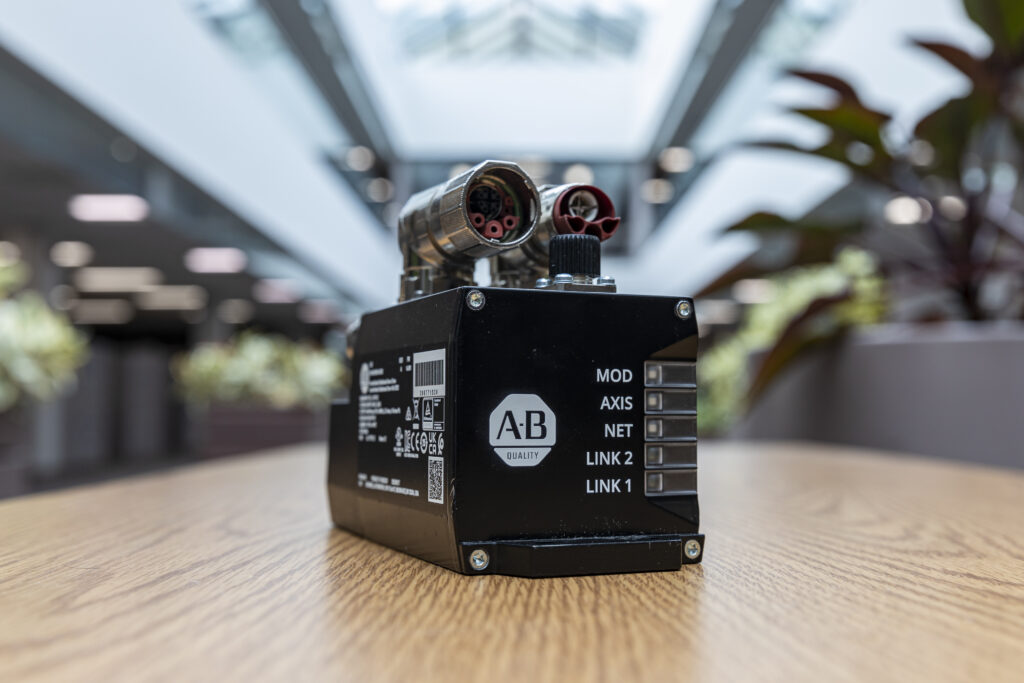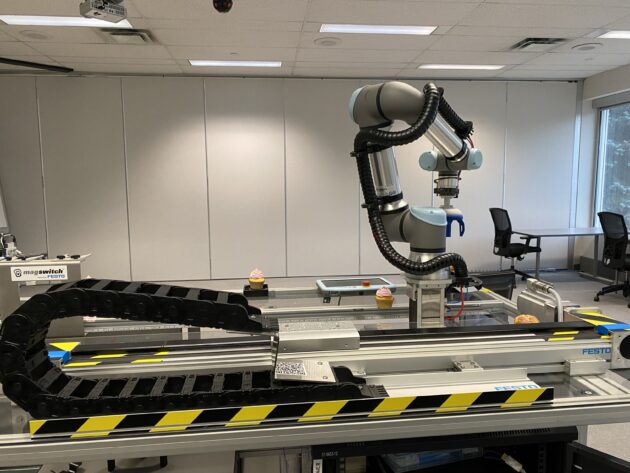
Emerging applications in motion control
January 8, 2024
By Treena Hein
An in-depth look at how new technologies are driving a range of new application areas in manufacturing.
 An on-machine module allows motion control integration in previously uncontrolled factory floor assets. (PHOTO: Rockwell Automation)
An on-machine module allows motion control integration in previously uncontrolled factory floor assets. (PHOTO: Rockwell Automation) Besides precision, accuracy and faster speed, motion control customers in the manufacturing industry are looking for new solutions that offer greater safety, ease of integration, flexibility and reduction of waste.
Industry is keeping up with many new innovations recently marketed or soon to launch. We approached industry stakeholders in the motion control space for insight into emerging trends and the technology behind them.
Hot new applications – replacing hydraulics and more
James C. Fadool, global OEM technical consultant at Rockwell Automation, points to a big current push to replace hydraulics with servo motors, as hydraulics are noisy, expensive, have safety issues and produce a lot of heat and waste oil. “It’s in its infancy but moving fast,” he says. “There have been smaller applications like a small assembly press in automotive, but now it’s into large applications like a large stamping press. You can also collect and store related data easily.”
In terms of other broad areas where motion control is expanding, Will Morris, motion control category manager at RS, points to packing and packaging. “We have three [systems] in our own warehouse that enable us to automatically pack certain-sized products and increase our shipments,” he says. “Some other uses we see are our filling, sealing and labelling machines.” Morris also lists medical/lab processes, CNC machining, 3D printing and cobot applications as growth areas for motion control.
More cobot applications supported by advanced safety features
With people-machine interaction increasing each year, the emergence of standardized advanced safety motion control features for cobots is happening now. An example is the advanced palletizer from Universal Robot & Robotiq, notes Warren Osak, president of Electromate. “They are designed with inherent safety features, allowing them to work harmoniously alongside humans without the traditional safety barriers,” he explains.
Advanced robot safety features include safe limited speed and positioning. “It’s a case of technology catching up with demand,” says Fadool. “Industry has been asking for improved safety functions such as safe limited positions for a long time and it’s great to be able to fill that need. Customers want the ability to safely move product as quickly as possible, but advanced positioning limitation also boosts process efficiency because recovery is so much faster after a jam occurs in terms of dealing with the issue and cleaning up.”
The ability to safely hold position during the cycle, for example, or while there is still material in the machine (as opposed to having to run it out of material) also means that less product falls down to become waste once a panel is opened to deal with a jam.
Wireless supports pneumatic and harsh environment applications
More and more motion control ‘communication’ is wireless, which works particularly well for pneumatic applications where data bandwidth is less intense (simple solenoid activation commands), explains Robert Almedia, business development manager at Advanced Motion & Controls. He adds that “operating in a frequency band not impacted by EMF noise from adjacent equipment can make communications even more robust and tolerant to harsh conditions. Using a wireless communication platform for motion control also provides a wireless communication hub for other associated sensors or devices employed in the motion control system.”
Modules extend motion control into previously uncontrolled assets and more
Fadool points to on-machine motion control as a major trend that provides multiple benefits and enables the integration of motion control in new material handling and packaging applications. “On-machine drives have been popular in smaller select applications for about ten years, but over the last four years or so, we’ve noticed much higher demand,” he reports. “We’ve therefore launched several dedicated on-machine solutions like Armor Kinetics and Armor Power Flex.”
Bolt-on motion control modules also mean just that: modularity. Customers can purchase them as desired to control motion in assets not controlled previously. Fadool adds that “with on-machine servo motors and drives, we can replace those that are clutch-based or mechanically driven, providing better efficiency and accuracy.” For the machine-building OEM, on-machine motion control modules also provide cost savings in panel development time. “There’s no need for huge build-out of panels and wiring,” says Fadool. “OEMs can build that same panel in probably one-quarter of the time.”
Another benefit of on-machine modules is saved spaced when doing re-fits. Machine size can be reduced with no excess cabinets required. “It’s a single-cable solution that’s really valuable for processes like packaging and automotive assembly,” says Fadool, “where every inch of space is at a premium.”
IO-Link boosts manufacturing flexibility/efficiency and more complex applications
The use of IO-Link communication protocol is steadily gaining popularity, according to Eric Rice, Festo product market manager, electric automation. “It provides real-time data exchange between sensors, actuators and controllers, enabling greater flexibility and efficiency in manufacturing processes,” he says. “With its plug-and-play simplicity and interoperability across various devices and vendors, IO-Link also simplifies system setup and maintenance. Additionally, it offers detailed diagnostic information, reducing downtime and enhancing predictive maintenance capabilities. IO-Link is increasingly embraced by users and well-supported by automation component suppliers. As a result, it’s expanding beyond its traditional applications in simple sensors and actuators to more complex devices like electromechanical linear axes.”
These linear high-precision motion control solutions (repeatability of +/- 0.015mm and speeds up to 1.3 m/s) are straightforward to control through IO-Link and offer uncomplicated point-to-point motion control without unnecessary features, explains Rice. “They also cost significantly less than traditional servo systems, which often have more functionality than required and therefore cost considerably more than alternative solutions, such as pneumatic cylinders. The affordability of these IO-Link linear axes places them in a comparable price range to pneumatic alternatives, making them an excellent upgrade path.”
Integrated controllers speed up application development
Almeida notes a trend of integrated controllers/drives in the robot/actuator – replacing an external controller (containing servo drivers, inputs/outputs, expansion slots and logic board) that typically requires panel space, can generate heat and usually has functionality aspects that aren’t required for every application. “For those more basic and straightforward applications. a family of robots has been developed that retains only the most often-used functionality and physically incorporates those components into the robot itself,” Almeida says. “This creates a very compact and effective robot package that is very simple to deploy (use typical wall voltage). This has made development of applications quicker and easier.”
Indeed, integration is enabling companies to deploy robots for smaller applications in-house. “Organizations can now take advantage of smaller-scale productivity gains, which when done multiple times, contribute largely to overall productivity,” Almeida observes. “As a bonus, when self-deployed, the organization ‘owns’ the solution, including the development. This means all the knowledge and understanding of the solution stays in-house, giving them the ability to modify and redeploy assets as needed without the need for external resources.” This approach also attracts new talent interested in development and design.
However, Almeida notes that as with all-in-one robots, some trade-offs are involved. “Typically, electrically-driven actuators are used when no air source is available, the application requires more than two positions or you require dynamic control of speed or force,” he explains. “These simpler designs function as an enhanced pneumatic actuator allowing for two or three positions without any programming needed, basically functioning like single or double solenoid valves or closed-center valves. Acceleration and speed can be dialed in at the actuator without the need for flow controls or specialized programming. With a big push on for energy conservation for economic and environmental reasons, machine builders are finding these actuators more attractive.”
Higher motion control speed and precision driving more SCARA applications
Osak reports that the use of SCARA robots such as the MCS500 from Mecademic are revolutionizing micro-assembly. “As manufacturing pushes the boundaries of speed and precision, SCARA robots are set to play an ever-increasing role,” he says. “In industries like electronics manufacturing, they adeptly handle tasks that require immense precision.”
Osak adds that in the automotive sector, the consistent repeatability of SCARA robots enable them to excel at inspection and testing, guaranteeing that every part meets and often surpasses stringent quality benchmarks.

A 7th axis is a linear transfer system for moving robots along another linear axis. (PHOTO: FESTO)
7th axis solution spurs more diverse motion control applications
Rice reports a trend to extend the reach of articulated robots by mounting the base to the moving carriage/mounting plate of an electromechanical linear actuator – referred to as a 7th axis solution.
“The 7th axis adds versatility to the robot’s capabilities, making it suitable for a more diverse set of tasks and applications,” Rice explains. “It can improve cycle times and reduce the need for repositioning the robot, increasing overall efficiency in an industrial setting.”
Better torque control spurs beverage, serialized part applications and more
Rockwell is being asked more and more about safe limited torque output torque monitoring in motion control applications. “It’s great to have this on the fly for things like bottling lines, ensuring lids and caps are applied with the correct amount of force,” Fadool explains. “This demand has been around for a while, and we’ve developed workarounds in the past, but about 18 months ago, we released a virtual torque sensor that gives customers the ability to increase process speed without impacting quality control, and they no longer need an external load cell to do this.”
And now that higher-speed computing/controllers and cheaper data storage are available, Rockwell’s sensor also allows customers to gather, analyze and store a lot more data related to torque. “We can measure everything to do with the motor and store that data along with the serialized part numbers, or timestamp in the case of bottling lines,” says Fadool.
Advertisement
- PTDA to host new talent development event to shape future leaders
- All industries aim to unify data and AI governance models, new MIT report finds